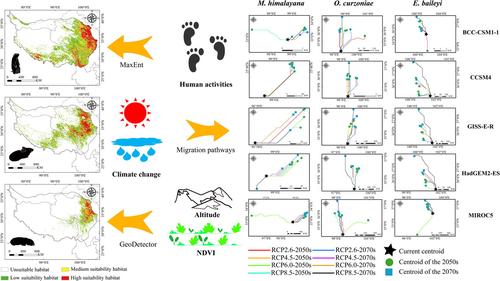当前位置:
X-MOL 学术
›
Pest Manag. Sci.
›
论文详情
Our official English website, www.x-mol.net, welcomes your feedback! (Note: you will need to create a separate account there.)
Impacts of climate change and human activities on three Glires pests of the Qinghai–Tibet Plateau
Pest Management Science ( IF 3.8 ) Pub Date : 2024-06-20 , DOI: 10.1002/ps.8250 Zhicheng Wang 1, 2 , Yanan Deng 1, 2 , Yukun Kang 1, 2 , Yan Wang 1, 2 , Duanhong Bao 1, 2 , Yuchen Tan 1, 2 , Kang An 1, 2 , Junhu Su 1, 2, 3
Pest Management Science ( IF 3.8 ) Pub Date : 2024-06-20 , DOI: 10.1002/ps.8250 Zhicheng Wang 1, 2 , Yanan Deng 1, 2 , Yukun Kang 1, 2 , Yan Wang 1, 2 , Duanhong Bao 1, 2 , Yuchen Tan 1, 2 , Kang An 1, 2 , Junhu Su 1, 2, 3
Affiliation

|
BACKGROUNDThe range of Glires is influenced by human activities and climate change. However, the extent to which human activities and environmental changes have contributed to this relationship remains unclear. We examined alterations in the distribution changes and driving factors of the Himalayan marmot, plateau pika, and plateau zokor on the Qinghai–Tibet Plateau (QTP) using the maximum entropy (MaxEnt) model and a geographical detector (Geodetector).RESULTSThe MaxEnt model showed that the contribution rates of the human footprint index (HFI) to the distribution patterns of the three types of Glires were 46.70%, 58.70%, and 59.50%, respectively. The Geodetector results showed that the distribution pattern of the Himalayan marmot on the QTP was influenced by altitude and the normalized difference vegetation index (NDVI). The distribution patterns for plateau pikas and plateau zokors were driven by HFI and NDVI. Climate has played a substantial role in shaping suitable habitats for these three Glires on the QTP. Their suitable area is expected to decrease over the next 30–50 years, along with their niche breadth and overlap. Future suitable habitats for the three Glires tended to shift toward higher latitudes on the QTP.CONCLUSIONThese findings underscore the impacts of environmental and human factors on the distribution of the three Glires on the QTP. They have enhanced our understanding of the intricate relationships between Glires niches and environments. This can aid in identifying necessary interventions for developing effective early warning systems and prevention strategies to mitigate Glires infestations and plague epidemics on the QTP. © 2024 Society of Chemical Industry.
中文翻译:

气候变化和人类活动对青藏高原三种害虫的影响
背景Glires的范围受到人类活动和气候变化的影响。然而,人类活动和环境变化在多大程度上促成了这种关系仍不清楚。我们利用最大熵(MaxEnt)模型和地理探测器(Geo detector)研究了喜马拉雅旱獭、高原鼠兔和高原鼢鼠在青藏高原(QTP)的分布变化和驱动因素。结果MaxEnt模型显示人类足迹指数(HFI)对三类Glires分布格局的贡献率分别为46.70%、58.70%和59.50%。地理探测器结果表明,喜马拉雅土拨鼠在青藏高原上的分布格局受海拔高度和归一化植被指数(NDVI)的影响。高原鼠兔和高原鼢鼠的分布模式是由 HFI 和 NDVI 驱动的。气候在为青藏高原上这三种灰鹬塑造合适的栖息地方面发挥了重要作用。预计它们的适宜区域在未来 30-50 年内将会减少,同时它们的生态位宽度和重叠也会减少。未来三种格里尔的适宜栖息地往往会向青藏高原上的高纬度地区转移。结论这些发现强调了环境和人为因素对青藏高原上三种格里尔分布的影响。它们增强了我们对 Glires 利基与环境之间复杂关系的理解。这有助于确定必要的干预措施,以制定有效的早期预警系统和预防策略,以减轻青藏高原上的格里雷感染和鼠疫流行。 © 2024 化学工业协会。
更新日期:2024-06-20
中文翻译:

气候变化和人类活动对青藏高原三种害虫的影响
背景Glires的范围受到人类活动和气候变化的影响。然而,人类活动和环境变化在多大程度上促成了这种关系仍不清楚。我们利用最大熵(MaxEnt)模型和地理探测器(Geo detector)研究了喜马拉雅旱獭、高原鼠兔和高原鼢鼠在青藏高原(QTP)的分布变化和驱动因素。结果MaxEnt模型显示人类足迹指数(HFI)对三类Glires分布格局的贡献率分别为46.70%、58.70%和59.50%。地理探测器结果表明,喜马拉雅土拨鼠在青藏高原上的分布格局受海拔高度和归一化植被指数(NDVI)的影响。高原鼠兔和高原鼢鼠的分布模式是由 HFI 和 NDVI 驱动的。气候在为青藏高原上这三种灰鹬塑造合适的栖息地方面发挥了重要作用。预计它们的适宜区域在未来 30-50 年内将会减少,同时它们的生态位宽度和重叠也会减少。未来三种格里尔的适宜栖息地往往会向青藏高原上的高纬度地区转移。结论这些发现强调了环境和人为因素对青藏高原上三种格里尔分布的影响。它们增强了我们对 Glires 利基与环境之间复杂关系的理解。这有助于确定必要的干预措施,以制定有效的早期预警系统和预防策略,以减轻青藏高原上的格里雷感染和鼠疫流行。 © 2024 化学工业协会。
















































 京公网安备 11010802027423号
京公网安备 11010802027423号